- El-Genk, M.S., T. Schriener, Lightweight Heat Pipe Radiator for Nuclear Reactor Power Systems on Lunar Surface. J. Nuclear Technology, 2025. 211(3) 400-428
- Kresl-Hotz, K.R., El-Genk, M.S., Schriener, T.M., Numerical Mesh Refinement for Flow Mixing in Pool Type SFR. Proceedings ANS Student Conference 2025, 2025.
- Kresl-Hotz, K.R., El-Genk, M.S., Schriener, T.M., CFD Analyses of the Flow Mixing and Stratification in Pool Type SFR. Proceedings ANS Student Conference 2025, 2025.
- El-Genk, M.S., T.M. Schriener, Lightweight Heat Pipe Radiator for Nuclear Reactor Power Systems on Lunar Surface. Nuclear Technology, 2024. 1-29
- Schriener, T.M., M.S. El-Genk, Armored Lightweight Heat Rejection Radiator for Lunar Surface Nuclear Reactor Power Systems. Proceedings ANS 2024 Nuclear and Emerging technologies for Space (NETS 2024), 2024.
- El-Genk, M.S., T. Schriener, Lightweight Heat Pipe Radiator Panel for Lunar Surface Fission Power Systems. Proceedings AIAA ASCEND Conference, 2024.
- El-Genk, M.S., Designs of Space Nuclear Reactor Power Systems for the Avoidance of Single Point Failures, Launch Safety, and a Long Operation Life. Proceedings AIAA ASCEND Conference, 2024.
- El-Genk, M.S, T.M. Schriener, R. Altamimi, A. Hahn, Pumping Options for Versatile Test Reactor Molten Lead In-pile Test Cartridge. J. Nuclear Science and Engineering, 2023. 197 3082-3109
- Altamimi, R., M.S. El-Genk, Equivalent Circuit Model for Predicting the Performance Characteristics of Direct Current-Electromagnetic Pumps. J Material Sciences and Engineering, 2023. 12(1) 629
- Altamimi, R., M.S. El-Genk, Miniature DC Electromagnetic Pumps of Molten Lead and Sodium to Support Development of Gen-IV Nuclear Reactors. J Nuclear Engineering and Design, 2023. 410 112376
ISNPS Director Mohamed El-Genk invited to be Panelist at Opening Plenary of 2024 ANS Winter Conference and Expo
12/4/2024
El-Genk invited speaker at the Open Plenary Panel at ANS Winter Meeting, 17-21, 2024
12/9/2024
Masters Graduation - Ahmad Shaheen
Ferris Engineering Center
Room 1120
Mailing Address:
Institute for Space & Nuclear Power Studies
MSC01-1120
1 University of New Mexico
Albuquerque, NM 87131
Phone: 505.277.5442
Fax: 505.277.5433
Online: Contact Form
Reactor Design and Space Radiation Effect and Shielding Analysis
1. MCNPX: Monte Carlo N-Particle eXtended
MCNPX is a three dimensional Monte Carlo code used to perform nuclear criticality analysis for reactor design and simulation as well as radiation shielding analysis. MCNPX was developed during the Accelerator Production of Tritium (APT) project by adding the LAHET physics nuclear models and high energy transport to the MCNP code, expanding MCNP's traditional capabilities for simulating transport of neutrons, photons, and electrons. The code utilizes evaluated nuclear cross section libraries for the transport of protons, neutrons, photons, and electrons such as ENDFB/VI and JENDL-3.3 up to 20 MeV and the LA150 libraries for up to 150 MeV, and physics models for higher energy particles.
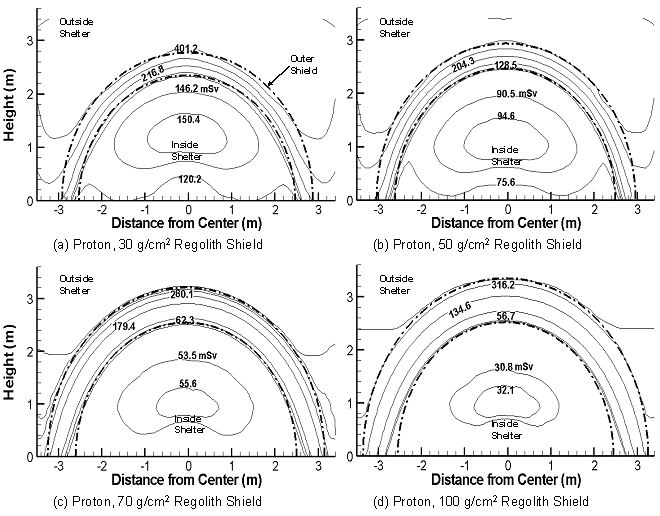
Figure 1.Figure 1. Protons' dose distribution inside lunar shelter with regolith shield thickness. February 1956 solar particle event source protons - isotropic incidence.1
The implementation of Los-Alamos Quark-Gluon String Model (LAQGSM) and Cascade-Exciton Model (CEM) improves the simulation of the interactions of light ions with materials and permits the code to perform transport calculations of over 2200 isotopes, ranging from 5He up to 259Fm, and increases the maximum energy limits to 1 TeV/n. 1,2 The current version of the code is capable of treating many particles such as: neutrons, anti-neutrons, protons, anti-protons, photons, electrons, positrons, muons, anti-muons, electron neutrinos, anti-electron neutrinos, positive pions, negative pions, neutral pions, short K-0s, long K-0s, positive kaons, negative kaons, deuterons, tritons, helium-3 ions, alphas, and heavy ions, including nucleus-nucleus interactions. The improved physics models along with a variety of sources, tally options, and the statistical analysis package make MCNPX a powerful tool for performing nuclear criticality safety calculations, neutronics analyses for the design of space and terrestrial nuclear reactors, and shielding caculations.1,2
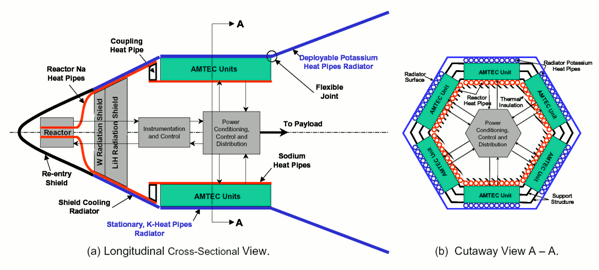
Figure 2. SAIRS, a 100 kWe space power system with heat pipes cooled nuclear reactor and alkali-metal thermal-to-electric (AMTEC) energy conversion units for longer space exploration missions. This concept operates fully passive with no single point failures with design redundancy.3,4
The implementation of the heavy-ion physics models allows the simulation of high energy space radiation shielding for astronauts and electronics, expanding beyond solar proton radiation to the entire GCR spectrum of heavier ions. The tools allowed us to assess what kind of secondary particles are possible, their relative fluxes, the total dose and the displacement damage energy deposition, and also a comparable view of different shielding materials. Such considerations are important for satellite design, shielding electronics1 and risk assessment for astronauts in long-term exploration and for lunar habitats (Figure 1)2; this is an example of many possible applications of MCNPX particle transport code.
For reactor applications MCNPX has an integrated fuel depletion capability based off of the CINDER90 burnup code. Fuel depletion is modeled over a series of user-specified time steps using neutron reaction rates calculated using 3-D Monte Carlo transport calculations. A predictor corrector scheme is used to calculate the reaction rates for each burnup time step to improve accuracy. This integrated feature allows a full core depletion analysis to be performed using the same geometry model and physics as the steady-state neutronics calculations. ISNPS uses MCNPX to perform lifetime analysis (Figure 6) of its space reactor concepts (Figures 2 - 4) as well as reactor operation cycle analysis for terrestrial nuclear power plants, and the design of small modular reactors for low power plants (5 - 50 MWe).3-10
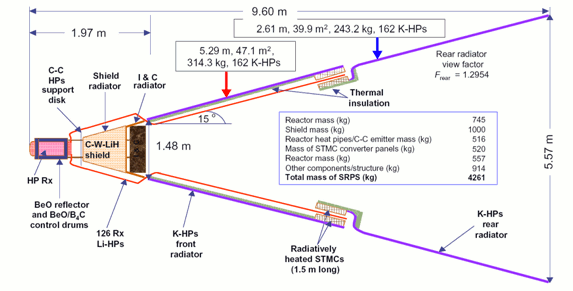
Figure 3. A layout of a power system with heat pipes-segmented thermoelectric modular converters (HP-STMCs) with a nominal electric power of 110 kWe for space exploration missions.3,9
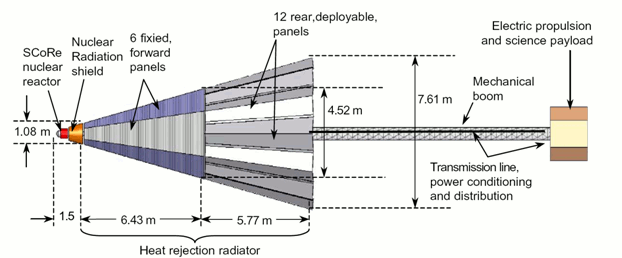
Figure 4. Liquid metal cooled, sectored compact reactor (SCoRe) space power system with SiGe thermoelectric conversion.
The power system provides 111.5 kWe for space exploration missions.3,5,8
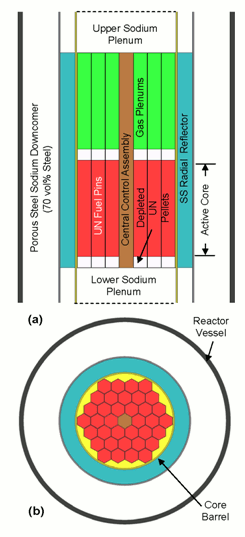
Figure 5. Cross-sectional views of the University of New Mexico's small modular reactor core (SMR-150 MWth).10
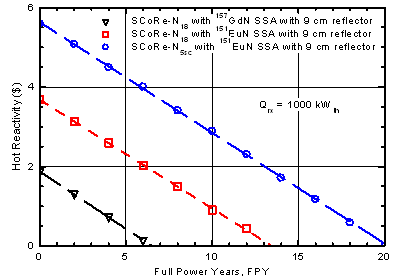
Figure 6. Operational life of selected SCoRe-N concepts at a nominal reactor power of 1 MWth.8
2. MCNP5 1.60: Monte Carlo N-Particle version 5
MCNP5 is a general Monte Carlo radiation transport code capable of transporting neutrons, photons, and electrons through virtually any material in various geometries. A versatile program, MCNP is used in modeling nuclear criticality and the design of space and terrestrial nuclear reactors and radiation shielding applications. ISNPS uses the latest version of MCNP5 to calculate reactor kinetics parameters for use in our transient analysis models.
3. PHITS (Particle and Heavy-Ion Transport System
PHITS is a three-dimensional general-purpose particle and heavy-ion Monte Carlo transport code that simulates the transport of particles and nuclei through complicated geometries. The code utilizes nuclear cross section data or nuclear models to evaluate and calculate fluxes, spectra, energy deposition distribution, doses, and many other observables. PHITS was developed mainly under the collaborations of JAEA (Japan Atomic Energy Agency), RIST (Research Organization for Information Science and Technology), KEK (High Energy Accelerator Research Organization), coupling the high energy particle transport code NMTC/JAM with heavy ion transport codes JQMD and SPAR. For neutrons transport with energies between 1 MeV and 20 MeV, the same method as in the MCNP4C code was implemented based on the evaluated nuclear data such as the ENDFB/VI and JENDL-3.3, and up to 150 MeV for the LA150 libraries. Above 20 MeV, the Bertini model with free p-p and n-n cross-sections parameter is used up to 3 GeV, while the simulation model JAM (jet AA microscopic transport model) is used above 3 GeV for nucleons, above 2.5 GeV for pions, and for all energies for all other baryons. The incorporation of the JAERI Quantum Molecular Dynamics (JQMD) makes it possible to model nucleus-nucleus interactions and estimate atoms fragmentation up to energies of 200 GeV/n. When simulating the transport of charged particles and heavy-ions, knowledge of the magnetic field can be important to estimate beam loss and heat deposition. PHITS code can provide arbitrary magnetic fields in any region of the setup geometry, simulating the trajectory of the particles in the field, and the collisions and the ionization process at the same time. ISNPS is currently using PHITS, in conjunction with MCNPX, to investigate the interactions of space radiations (solar particles and galactic cosmic radiation), and calculate the resulting particle fluxes inside space station and potential habitat, and the estimated doses to astronauts.
4. ORIGEN-ARP: Origen Automated Rapid Processing
Origen-ARP is an isotopic depletion and decay analysis program designed to characterize nuclear fuel assemblies. Part of the SCALE package, Origen-ARP provides for fast characterization of nuclear fuel under irradiation and decay conditions. ARP provides the Origen-S isotopic depletion code with problem dependent 1-group cross sections for its burnup calculations. Extensive assembly-dependent libraries exist for almost any commercial reactor currently in use, with the capability of generating new libraries for unique fuel compositions or assembly designs. Origen-ARP has been used at ISNPS to study the behavior of MOX, (U,Th)O2, and inert matrix fuels for use in next generation commercial nuclear reactors for reducing the production of minor actinides and the mass and the volume of spent nuclear fuel.
5. SCALE 5.1: Standardized Computer Analyses for Licensing Evaluation version 5.1
SCALE is a modular code that couples together functional modules, such as transport or depletion codes, allowing for combined analysis to be performed with a single code package. The program allows the user to use the same code package for handling neutronics, fuel burnup, shielding, and other interrelated analysis in a coupled environment. SCALE 5.1 contains the 3D Monte Carlo transport codes KENOV and KENOVI, the burnup code ORIGEN-S, TRITON, which links the 2D discrete ordinates code NEWT with Origen-S, and TRITONVI which links the 3D Monte Carlo code KENOVI with ORIGEN-S for 3-D fuel depletion analysis, among many others. ISNPS uses SCALE for studies involving commercial power reactors and advanced nuclear fuel cycle and fuel management applications.
- 1. Pham, T. T, M. S. El-Genk, "Shielding Electronics Devices from Mono-energetic 100 Mev Protons," J. Nuclear Science and Engineering, 166, 2010, 58 - 72.
- 2. Pham, T. T, M. S. El-Genk, "Dose Estimates in a Lunar Shelter with Regolith Shielding," Acta Astronautica, 64, 2009, 697 - 713.
- 3. El-Genk, M. S., "Space Nuclear Reactor Power System Concepts with Static and Dynamic Energy Conversion," J. Energy Conversion and Management Special Issue on Space Nuclear Power and Propulsion, 49 (3), 2008, 402 - 411.
- 4. El-Genk, M. S. and Jean-Michel Tournier, "SAIRS" - Scalable AMTEC Integrated Reactor Space Power System," Progress in Nucl. Energy, 45(1), 2004, 25-69.
- 5. Hatton, S. H. and M. S. El-Genk, "Sectored Compact Space Reactor (SCoRe) Concepts with a Supplementary Lunar Regolith Reflector," J. Progress in Nuclear Energy, 51, 2009, 93 - 108.
- 6. King, J. C. and M. S. El-Genk, "Thermal-Hydraulic and Neutronic Analyses of Submersion-Subcritical, Safe Space (S^4) Reactor," J. Nuclear Engineering and Design, 239(12), 2009, 2809 - 2819.
- 7. El-Genk, M. S. and Schriener, T. M., "Performance and Radiological Analyses of Space Reactor Power System Deployed into a 1000 - 3000 km Earth Orbit," J. Progress in Nuclear Energy, 52, 2010, 236 - 248.
- 8. Schriener, T. M. and M. S. El-Genk, "A Neutronics Analysis of Long-Life, Sectored Compact Reactor Concepts for Lunar Surface Power," J. Progress in Nuclear Energy, 53(1), 2011, 106 - 118.
- 9. Mondt, J., K. Johnson, J.-P. Fleurial, M. S. El-Genk, P. Frye, and W. Determan, "Segmented Thermoelectric Multicouple Converter Technology Development," Proceedings of Space Technology and Applications International Forum (STAIF-05), AIP Conference Proceedings No. 746, American Institute of Physics, Melville, NY, 2005, 495 - 502.
- 10. Schriener, T. M. and M. S. El-Genk, "Neutronic Optimization of UN Fuel Pin Assemblies for a Sodium Cooled, Small Modular Reactor," Proceedings, ASME 2011 Small Modular Reactors Symposium, paper No. SMR2011-6631, Washington, DC, 28 - 30 September, 2011.
 Back to The Top
Back to The Top 


